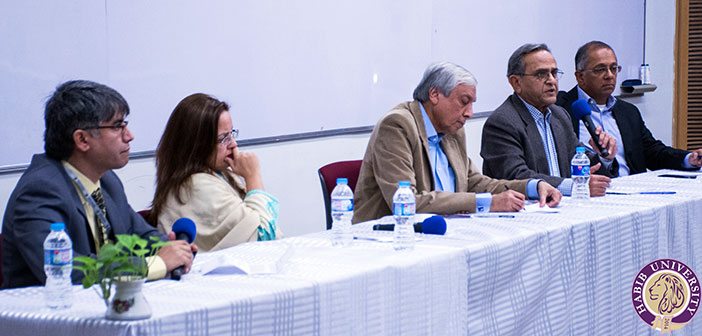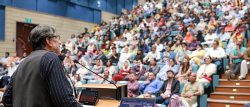Industry experts seek answers from Pakistan Atomic Energy Commission at the Yohsin Center for Social Development
HABIB UNIVERSITY, December 15, 2015: The second Teach-in for the Yohsin Center for Social Development (YCSD) happened on Saturday, December 12 at Habib University, wherein the topic of discussion was the nuclear power plants being erected near the city of Karachi.
The moderator of the talk, Dr. Hafeez Jamali; Interim Director (Social Development and Policy, Habib University), invited a panel of industry experts to understand, realize and expand broader discourse on the dangers of constructing new nuclear power plants so close to the city, while a representative from the Pakistan Atomic Energy Commission (PAEC) helped in deconstructing these questions.
The panel of experts invited for this Teach-in were made up of prominent names, such as Dr. A.H Nayyar, the renowned Pakistani nuclear activist and physicist; Dr. Ansar Parvaiz, a Pakistani scientist and nuclear engineer representing the PAEC; Dr. Nausheen Anwar, Assistant Professor at Institute of Business Management (IBA), specializing in Urban and Regional planning; and Dr. Arif Belgaumi, renowned architect representing Arif Belgaumi Architects.
Done in collaboration with the Pakistan Institute for Labor Education and Research (PILER), the discussion was highly energetic and extensive, offering great insight into the infrastructure of nuclear energy in Pakistan and its effects on civil society.
Each panelist was invited to bring forth their concerns about the fallout from the Karachi Nuclear Power Complex, or KNPC, laying out their questions for Dr. Ansar Parvaiz who has been a part of the organization for more than 40 years. Being civil society activists, each panel member bought forth separate arguments against the construction of more nuclear plants within Pakistan.

Dr. Parvaiz took each query in consideration and offered an in-depth analysis and justification for each. Being a strong supporter for peaceful civilian used nuclear technology in Pakistan, he also commented on how environmental and cultural factors tie in with the establishment of the two new power plants in Karachi, namely the K2 and K3 nuclear reactors.
One of the concerns raised during the Teach-in was by Dr. A.H Nayyar, who informed the audience of their concern that KANUPP is listed in global literature as one of the worst possible working reactors.
“Operating at only 28% capacity as per international literature, we can of course say that the danger is not as much as it could be, however we can’t just say there isn’t any danger, as we are discouraged from measuring it by the PAEC itself”.
Referring to reports from the region of Dera Ghazi Khan, he spoke of how the mine workers have actually gone on strike due to the effect of radiation to them and their families.
Dr. Nausheen took this argument further, and spoke of how, even in the face of technological innovation, we are facing a major crisis.
“Why is it that, at a time when globally nuclear power plants are being constructed at smaller scales, which are relatively cheaper and safer, we are still stuck in the construction of mega-projects such as these, taking away money and resources that could be used elsewhere?”
Referring to the Fukushima accident earlier in the year, Dr. Belgaumi commented on the nature of such incidents, of how there is no way to assess the damage to the population density around nuclear reactors for years to come.
“Our concern is, accidents happen, in all human endeavor there is a risk of the unknown. Can we really afford it with these reactors so close to the city? There is not even a whole 15 kilometer distance from the city of Karachi, and although we can speak of the technological wonders of these plants, there is no way we can foresee the danger ahead”.
Although Dr. Ansar Parvaiz provided solid facts against each concern spoken about by the panelists, the topic was brought to a close informing the audience that there are functional, and safer alternatives to nuclear energy, and it is high time that Pakistan as a nation start looking into them, rather than walking precariously into the midst of potentially damning consequences.




